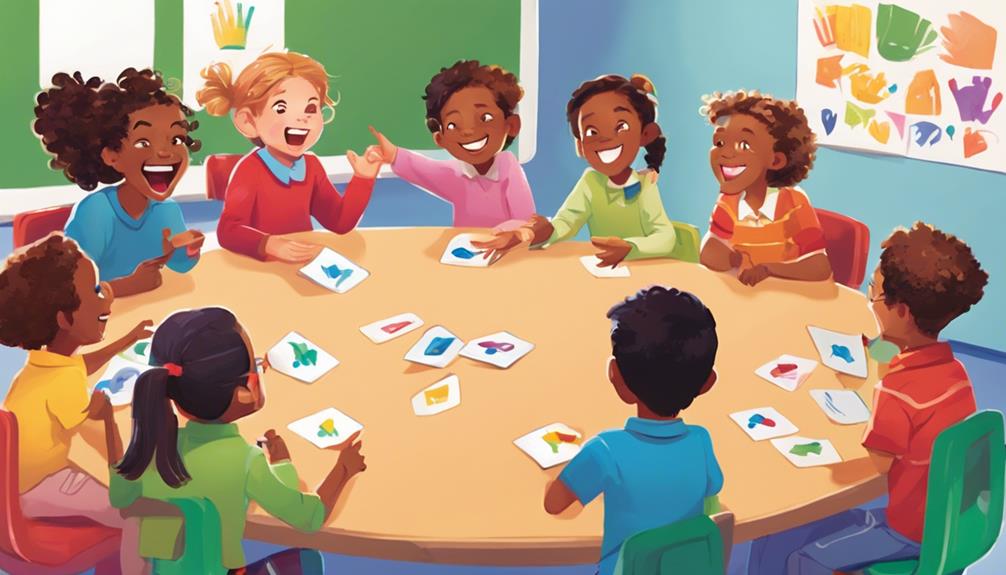Developing English speaking skills in Class 1 students requires a multifaceted approach that incorporates confidence building, a supportive environment, engaging conversational activities, and opportunities for self-expression and creativity. Building confidence through low-stakes conversations and self-reflection is essential for effective communication. Creating a supportive environment through clear expectations and positive reinforcement fosters growth and improvement. Engaging in conversational activities, encouraging self-expression, and making language learning fun can further enhance speaking skills. By adopting a growth mindset and incorporating innovative activities, educators can tap into the full potential of their students, and with further exploration, discover even more strategies to accelerate language development.
Building Confidence in Speaking

Many non-native English speakers struggle to express themselves effectively in English, and this struggle often stems from a lack of confidence in their speaking abilities.
This lack of confidence can lead to hesitation, stumbling, and even complete avoidance of speaking in English. However, building confidence in speaking is vital for effective communication and can be achieved through practice, self-reflection, and a growth mindset.
One effective way to build confidence is to start small, beginning with low-stakes conversations and gradually increasing the difficulty level.
This can involve speaking with native speakers, engaging in role-plays, or recording oneself and listening to the recordings. Self-reflection is also essential, as it allows individuals to identify areas for improvement and develop strategies to overcome them.
Additionally, adopting a growth mindset and viewing mistakes as opportunities for growth can help to reduce anxiety and increase confidence.
Creating a Supportive Environment
A supportive environment is the cornerstone of effective language learning, providing a sense of security that fosters growth and improvement.
When children feel comfortable and supported, they are more likely to take risks and engage in language activities, leading to improved speaking skills. To create a supportive environment, teachers and parents can establish clear expectations and rules, encouraging respectful communication and active listening.
A well-organized classroom or learning space can also help reduce anxiety and promote focus.
In addition, using positive reinforcement and praise can motivate children to participate and build their confidence.
It is essential to minimize criticism and correction, focusing instead on providing constructive feedback that guides improvement. By creating a safe and inclusive space, children will feel encouraged to speak up and engage with the language, leading to improved speaking skills and a lifelong love of learning.
Engaging in Conversational Activities

Children who feel comfortable in a supportive environment are more likely to engage in conversational activities that help them develop their English speaking skills.
These activities provide opportunities for students to practice their speaking skills in a low-stakes setting, building their confidence and fluency. In class, this can be achieved through paired conversations, group discussions, or role-plays.
Teachers can facilitate these activities by providing prompts or topics, encouraging students to ask questions, and offering guidance and feedback. Conversational activities can also be incorporated into daily routines, such as morning greetings or sharing sessions, to create a culture of communication in the classroom.
Encouraging Self-Expression and Creativity
Fostering an environment that encourages self-expression and creativity is essential for developing English speaking skills, as it allows students to tap into their thoughts, feelings, and experiences, making their language use more authentic and engaging.
This can be achieved by providing opportunities for students to share their personal experiences, opinions, and ideas, and by encouraging them to take risks and try out new language structures and vocabulary.
Teachers can also promote self-expression by using open-ended questions that prompt students to think critically and creatively, and by giving them autonomy to choose topics that interest them.
Additionally, incorporating storytelling, role-plays, and creative writing activities into the classroom can help students develop their language skills in a more engaging and meaningful way.
Making Language Learning Fun

Through innovative and engaging activities, language learning can be transformed from a tedious chore into an enjoyable experience that motivates students to improve their English speaking skills.
When learning is fun, students are more likely to participate actively, ask questions, and engage in conversations, ultimately developing their oral communication skills.
Games, role-plays, and interactive exercises can be incorporated into the curriculum to make language learning an exciting experience.
For instance, language-based board games or card games can be used to practice vocabulary and grammar in a competitive yet enjoyable manner.
Similarly, role-plays can be designed to simulate real-life scenarios, encouraging students to use English in context.
Frequently Asked Questions
How Do I Handle Shy or Reluctant Students in the Classroom?
To handle shy or reluctant students, create a supportive classroom environment by establishing trust, using non-threatening activities, and providing individualized encouragement, allowing them to build confidence and gradually participate in class discussions.
Can Non-Native English Speakers Be Effective English Teachers?
While native speaker status is often associated with language teaching, non-native English speakers can be effective English teachers, bringing unique perspectives and empathy to the classroom, as long as they possess strong language proficiency and pedagogical skills.
What if I Don't Have Access to Educational Resources or Technology?
Limited access to educational resources or technology can hinder learning outcomes, but creative alternatives exist. Leverage community resources, peer-to-peer learning, and traditional teaching methods to foster engagement and knowledge acquisition in the absence of modern tools.
How Do I Assess Student Progress in Speaking Skills?
To assess student progress in speaking skills, utilize observational checklists, verbal feedback, and peer evaluation to monitor fluency, pronunciation, and comprehension. Record student speeches or conversations to track improvement and identify areas for targeted support.
Can English Speaking Skills Be Developed Outside the Classroom?
Indeed, English speaking skills can be developed outside the classroom through self-directed learning, interactive apps, and real-life conversations, enabling learners to practice and refine their language abilities in a more autonomous and authentic manner.
Conclusion
Building Confidence in Speaking
Class 1 students often struggle to express themselves in English due to lack of confidence. To overcome this, teachers can use positive reinforcement, encouraging students to speak without fear of mistakes. This helps build confidence and develops fluency.
Creating a Supportive Environment
A supportive classroom environment is essential for improving English speaking skills. Teachers should create a safe space where students feel comfortable expressing themselves without fear of ridicule or criticism.
Engaging in Conversational Activities
Conversational activities, such as role-plays, group discussions, and debates, help students practice speaking in a more interactive and engaging way. These activities encourage students to think critically and respond spontaneously.
Encouraging Self-Expression and Creativity
Encouraging self-expression and creativity helps students develop their own voice and opinions. Teachers can use open-ended questions, storytelling, and creative writing activities to promote self-expression and creativity.
Making Language Learning Fun
Making language learning fun and engaging is vital for improving English speaking skills. Teachers can use games, songs, and multimedia resources to create an enjoyable learning experience.
Conclusion
Effective strategies for improving English speaking skills in Class 1 students include building confidence, creating a supportive environment, engaging in conversational activities, encouraging self-expression and creativity, and making language learning fun. By implementing these strategies, students can develop fluency, critical thinking, and effective communication skills.




0 Comments